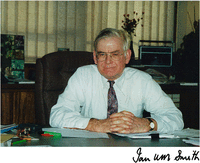Ian William Murison Smith facts for kids
Quick facts for kids
Ian Smith
FRS FRSC
|
|
|---|---|
 |
|
| Born |
Ian William Murison Smith
15 June 1937 |
| Died | 8 November 2016 (aged 79) |
| Education | Giggleswick School |
| Alma mater | University of Cambridge (BA, MA, PhD) |
| Spouse(s) |
Sue Morrish
(m. 1961) |
| Awards | Tilden Prize (1983) Polanyi Medal (1990) |
| Scientific career | |
| Fields | Chemistry |
| Institutions | University of Birmingham University of Cambridge |
| Doctoral advisor | Tony Callear |
| Doctoral students | Gus Hancock David Klenerman |
Ian William Murison Smith (born June 15, 1937 – died November 8, 2016) was a brilliant British chemist. He spent many years teaching and researching at two famous universities. He worked at the University of Cambridge from 1963 to 1985. Later, he became a Professor of Chemistry at the University of Birmingham, from 1985 to 2002. He was known for his important work in understanding how chemicals react.
Ian Smith's Early Life and Learning
Ian Smith went to Giggleswick School when he was younger. This school is in a part of England called West Riding of Yorkshire. After school, he went to the University of Cambridge. There, he studied a course called the Natural Sciences Tripos. He was a student at Christ's College, Cambridge.
He finished his first degree in 1960. Then, he continued his studies to get a PhD, which is a very high university degree. He earned his PhD in 1964. His supervisor, who guided his research, was a person named Tony Callear.
Amazing Discoveries in Chemistry
Ian Smith was a top researcher in several exciting areas of chemistry. He studied how fast chemical reactions happen. This is called reaction kinetics. He also looked at how energy moves around during these reactions. This is known as energy transfer.
Another area he explored was molecular dynamics. This means studying how tiny molecules move and interact. He focused on these topics in gas phase systems. These are systems where chemicals are in a gas form.
Because of his important work, he received many honors. In 1995, he became a Fellow of the Royal Society (FRS). This is a very special award for top scientists. He also became a Fellow of the Royal Society of Chemistry (FRSC).
He won two major awards from the Royal Society of Chemistry. He received the Tilden Prize in 1983. Later, in 1990, he was given the Polanyi Medal. Many students learned from him. Two of his former PhD students include David Klenerman and Gus Hancock.
Ian Smith's Family Life
Ian Smith married Sue Morrish in 1961. They had four children together.

